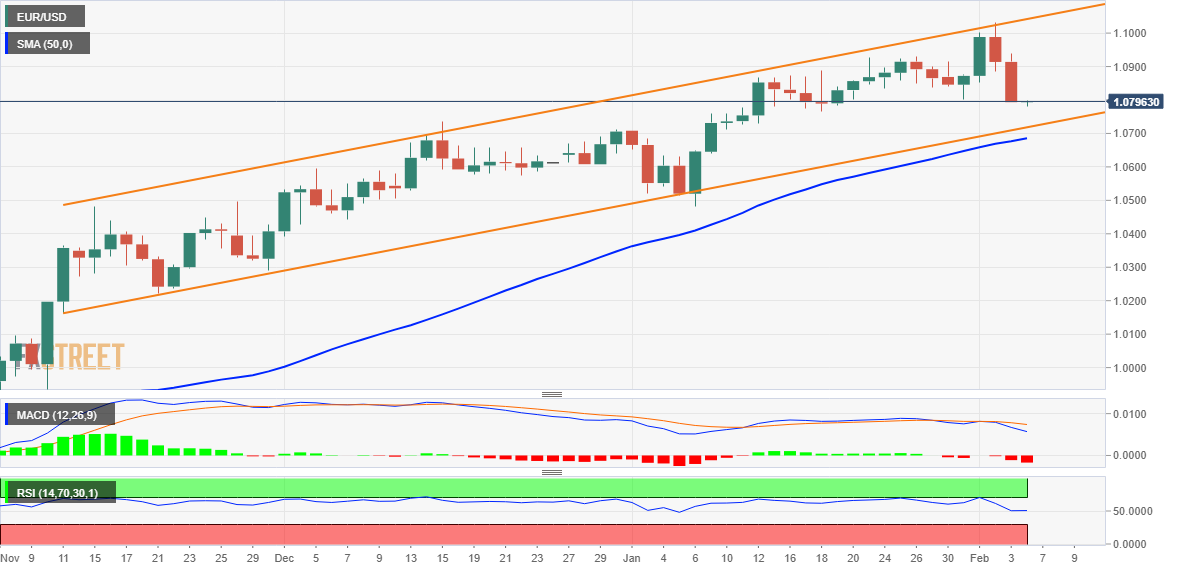- EUR/USD finds support near the 1.0780 area and stalls its recent pullback from a multi-month top.
- The upside potential seems limited amid a turnaround in the sentiment surrounding the greenback.
- The stellar US NFP report should allow Fed to keep hiking interest rates and favours the USD bulls.
The EUR/USD pair witnessed heavy selling for the second straight day on Friday and retreated further from its highest level since April 2022 touched the previous day. The US Dollar rallied across the board in reaction to the stellar US monthly employment details and turned out to be a key factor exerting downward pressure on the major. The headline NFP print showed that the economy added 517K jobs in January, surpassing even the most optimistic estimates. The previous month's reading was also revised higher to show an addition of 260K vacancies as compared to the 223K reported originally. Furthermore, the unemployment rate unexpectedly dipped from 3.5% in December to 3.4% – the lowest since May 1969.
Average Hourly Earnings, meanwhile, rose 0.3% MoM and 4.4% over the past 12 months, down from 0.4% in December and 4.9%, respectively. Nevertheless, the data was strong enough to allow the Federal Reserve to keep hiking interest rates. It forced investors to scale back their bets for an imminent pause in the policy-tightening cycle. This, in turn, pushed the US Treasury bond yields sharply higher and triggered aggressive short-covering around the USD. Apart from this, the risk-off impulse was another factor that assisted the safe-haven buck to rebound swiftly from a nine-month low. However, the EUR/USD pair finds some support near the 1.0780 area, or over a two-week low touched during the Asian session on Monday.
That said, the upside remains capped amid a turnaround in the sentiment surrounding the USD, which continues to draw support from rising US bond yields and a softer risk tone. This, in turn, warrants some caution before placing fresh bullish bets around the EUR/USD pair. Market participants now look forward to German Factory Orders, which, along with the Eurozone Sentix Investor Confidence Index and Retail Sales data, might influence the shared currency. Apart from this, the USD price dynamics should provide some meaningful impetus to the major without any relevant market-moving economic releases from the US.
Technical Outlook
From a technical perspective, any subsequent fall will likely find some support near the lower end of over a two-month-old ascending channel, currently around the 1.0725 region. This is closely followed by the 1.0700 mark and the 50-day SMA, near the 1.0680 zone. A convincing break below the latter will be seen as a fresh trigger for bearish traders and set the stage for a further near-term corrective decline.
The EUR/USD pair might then turn vulnerable to weaken further below the 1.0600 round figure and accelerate the slide towards the 1.0550 region. Spot prices could eventually drop to the 1.0500 psychological mark en route to the January 2023 swing low, around the 1.0480 area.
On the flip side, the immediate hurdle is pegged near the 1.0855-1.0860 horizontal zone, above which the EUR/USD pair could climb to the 1.0900 mark. Some follow-through buying will negate any near-term negative bias and allow spot prices to reclaim the 1.1000 psychological mark with some intermediate resistance near the 1.0975-1.0980 region.






